Bōm
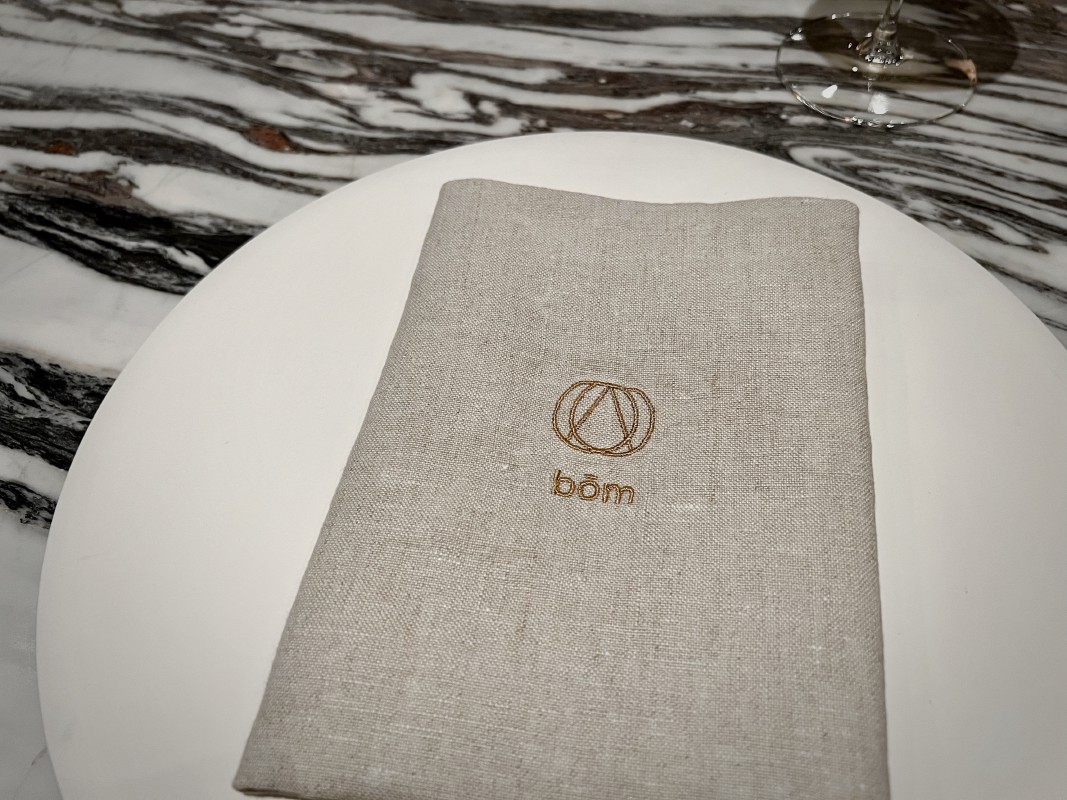
Bom is a restaurant located in the back room of its sibling restaurant, Oiji Mi. We had been to that before, and I thought it was pretty decent. Bom was always on my list of things to try, but at $295 per person, I was pretty hesitant and skeptical. This restaurant doesn’t even have a Michelin Star yet. Since reservations are fairly easy and Oiji Mi was pretty good, I thought I’d give this a try since we were celebrating two major milestones in our lives.
From the website, it describes Bom as:
an immersive dining experience for the senses, featuring a progressive Korean tasting menu at an intimate chef’s counter with custom built-in grills. Led by Michelin-starred chef Brian Kim and the OIJI MI team, guests are invited to an elevated sensory experience that integrates a unique steakhouse concept as they enjoy an exclusive first-row view of the chefs’ work. The highly curated courses offer a modern perspective on Korean traditional cuisine with a creative angle, highlighting the essence of each seasonal ingredient.
bōm, meaning “Spring” in Korean, is also an abbreviation of “behind OIJI MI.” Secretly tucked behind its counterpart, cuisine and design come together in a harmony of creativity and craftsmanship in the refined space, with inspiration from Korean traditional architecture and the deep violet color of Korean royal courts reflected throughout.
Ambiance & Service
When we walked into the host at the front of Oiji Mi, we were greeted by the host. They lead you to the back room of the main dining room, where you see a u-shaped counter with BBQ grills in front of a set of seats. The counter seats about 20 people at most, so it’s fairly limited space. As soon as you walk in here, you are greeted by one of the servers, and they ask about your allergies. Throughout the night, our waters were never empty, and it was easy to get ahold of any one of the bustling chefs in the kitchen.
I had ordered the wine pairing ($275) which was steep, but I am in this strange mode where I am trying to learn more about wines. The sommelier was very nice and answered a lot of my dumb questions. What really surprised me was that for each course, it was a pretty generous pour, and I was slightly getting tipsy about 3/4 of the way through the meal even with my partner sipping some of my wine. I really enjoyed the wine pairing because it had very complex and distinct flavors that were different than your typical wine pairings. It’s definitely something your party should consider getting if you truly want to try something different than your French wine pairings. The sommelier procures a lot of wine from various regions from small vineyards that don’t sell to the public. It’s quite a trip!
Our meal lasted about 2.5 hours, and the other diners had already left. I will say that I was pleasantly surprised by the number of courses and how it was split up. The first few are seafood centric, and the second are steak focused. We didn’t feel too much pressure to hurry other than the fact there was hardly anyone there, so it was awkward. Regardless, the chefs still accommodated us.
Now let’s get to the food, which is around 12 courses with some little things here and there.
Food
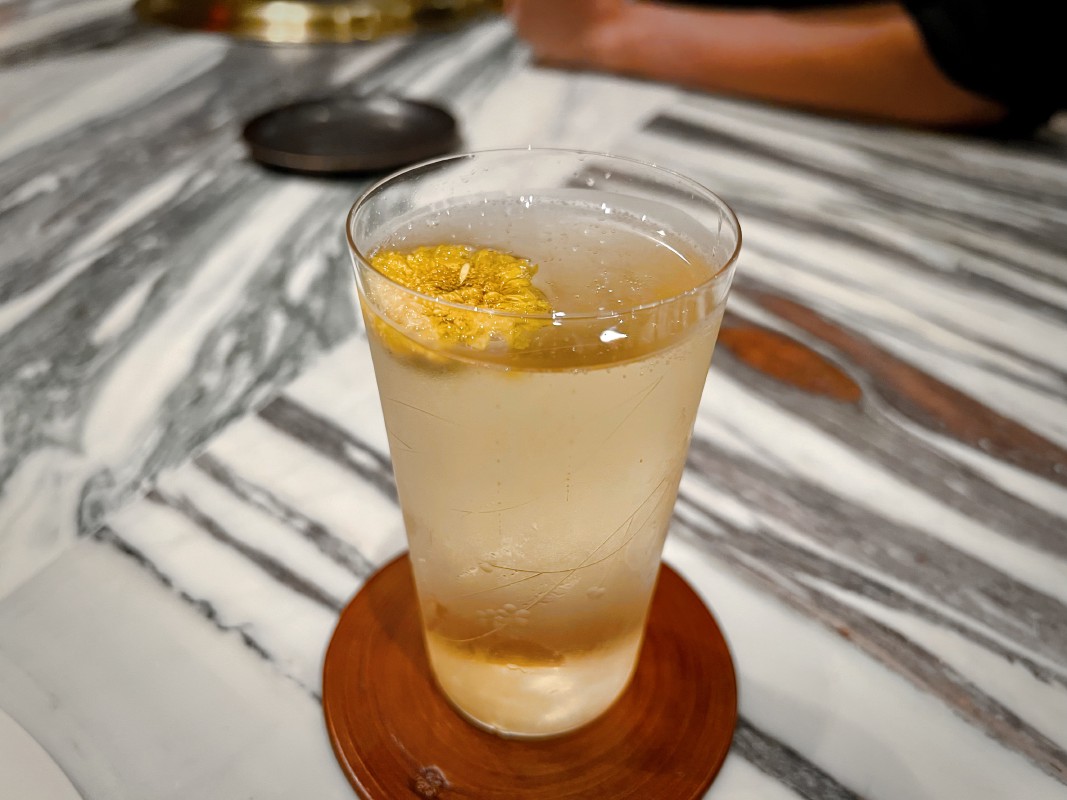
The Monet Life ($35) cocktail came with blanc de noirs, cazottes poire, and pear shrub. This was a very expensive cocktail, and thank goodness, they gave a decent serving of it for this steep price point. The cocktail reminded me of a spritz with summer flowery notes to it. It is very fruit forward, with some interesting salt aftertastes as you let it sit for a while.
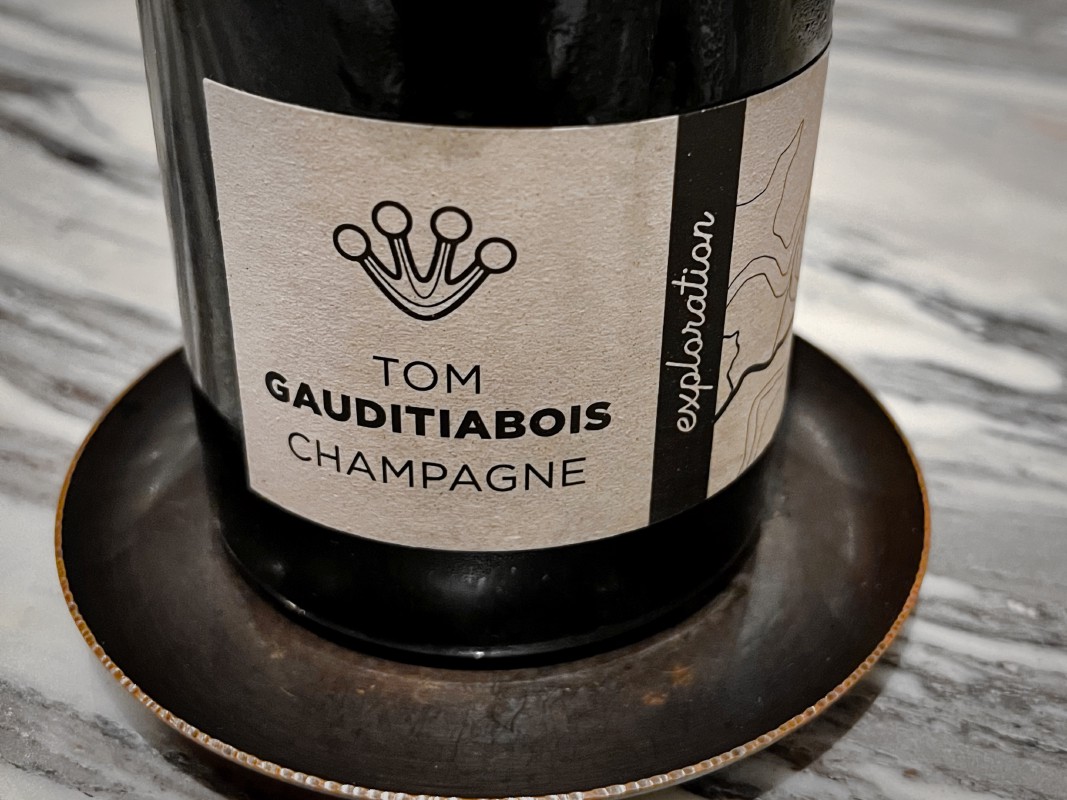
The first pairing was the Tom Gauditiabois Champagne, which was Exploration No.3, brut nature, and came from Chezy-Sur-Marne, France, nv (non-vintage). This was quite interesting in that it was half pinot noir and half chardonnay. The pinot noir added some texture and interesting flavors to the champagne such that it wasn’t boring or typical. It was very good.
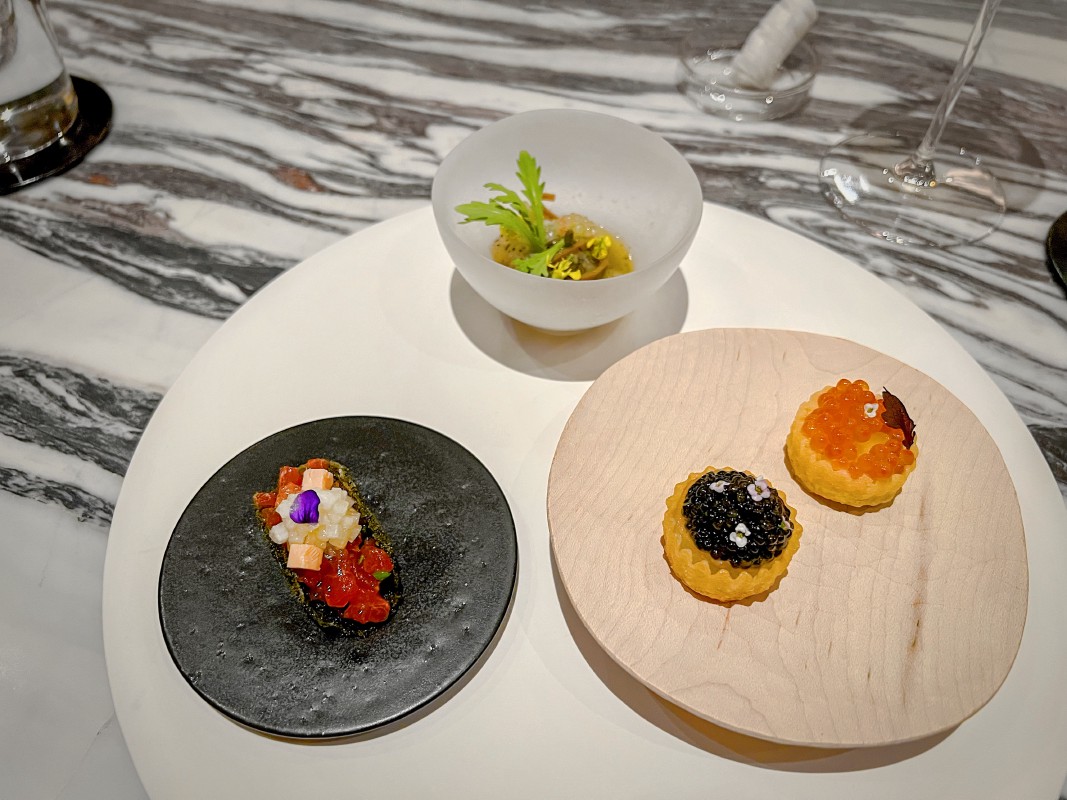
The appetizers came with four small amuses (bottom left, clockwise):
- bluefin tuna with Hudson Valley foie gras and gamtae seaweed - this was like a little taco and tasted like it was seasoned with soy sauce and seaweed.
- maine diver scallop with finger lime - the scallop was delicious and plump. The sauce was citrus focused.
- baesuk (Korean steamed pears) with ossetra caviar, jujube, and tofu - they gave you a very generous portion of caviar
- gyeran (egg bread) with trout roe and apple - this was also very good too
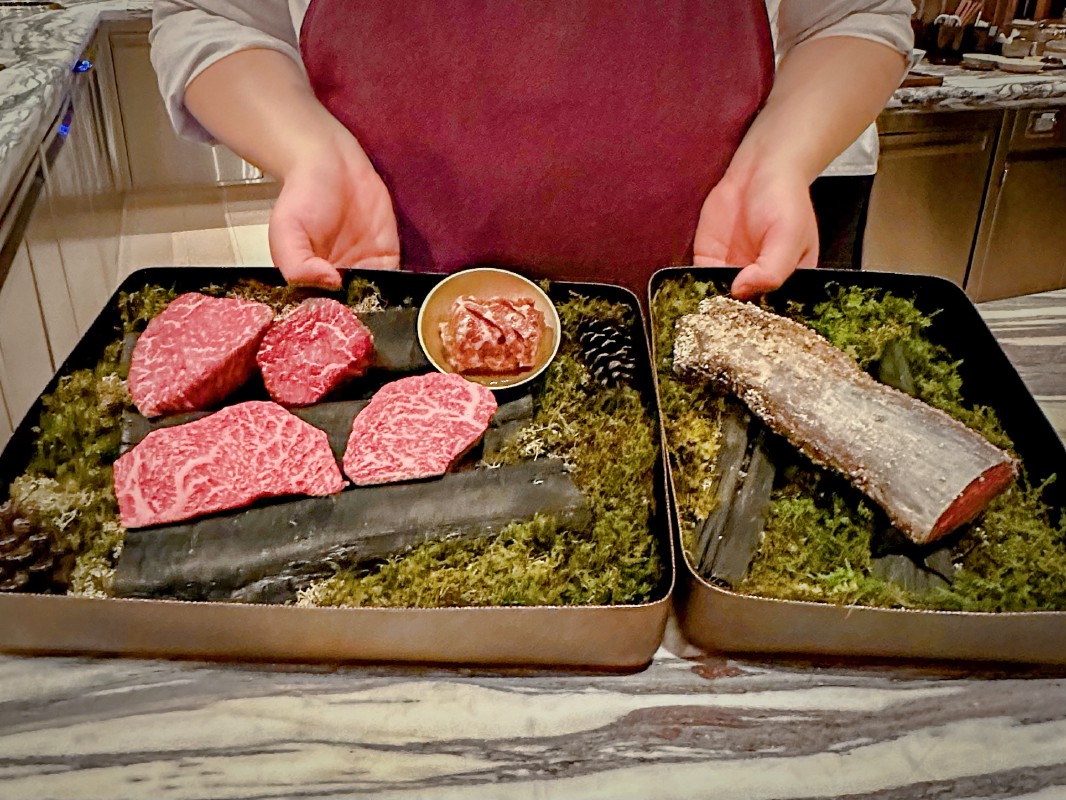
They brought out the steak plates to show the meat they are cooking for us. Starting top to bottom, left to right:
- aged tenderloin - Jack’s Creek farm in Australia, very nutty and distinct in character
- tenderloin wet aged - from same the farm but much more mellow
- wagyu galbi - Snake River Farms Idaho
- A4 wagyu from Kagoshima
- Aged ribeye (far right)
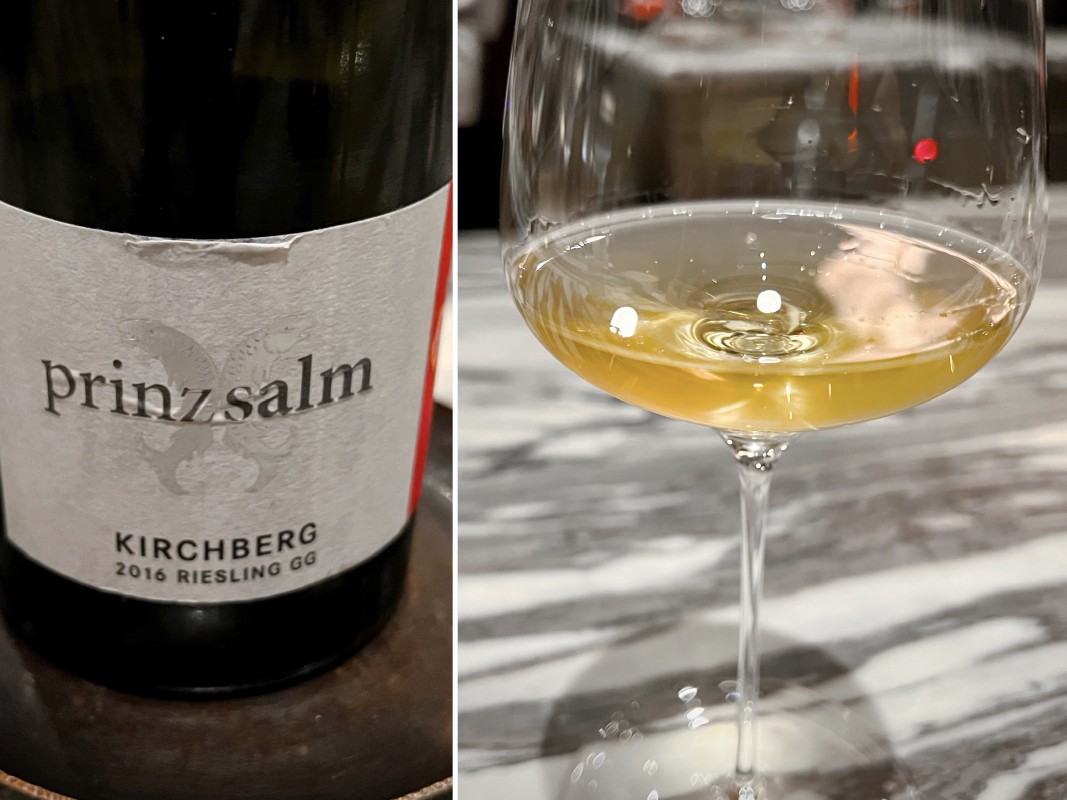
The second pairing is the Prinz Salm came from Binger Kirchberg GG, Rheinhessen, Germany 2016. This was a very different riesling than what I normally have tried. It was more zesty and juicier, so it had a very different atypical, albeit enjoyable, aftertaste.
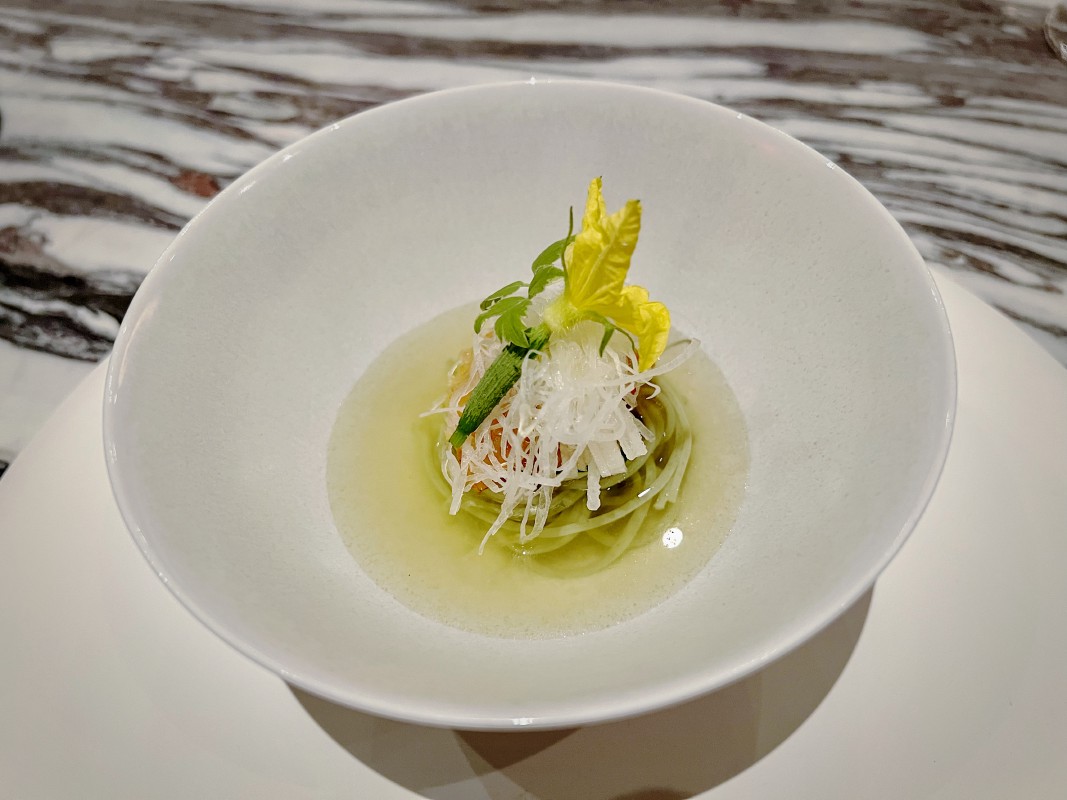
The mul hwe was a sea bream, gamtae noodle, and chojang (sweet, tangy, spicy Korean sauce). The sea bream was lathered in the chojang. It was served with chilled cucumber broth and an edible cucumber blossom. The sea bream was delicious, and the chilled cucumber broth was a nice counter to this hot humid day. This broth is very similar to the Korean cold noodle soups except it has a very balanced flavor along with it being perfectly peppery and not overwhelming.
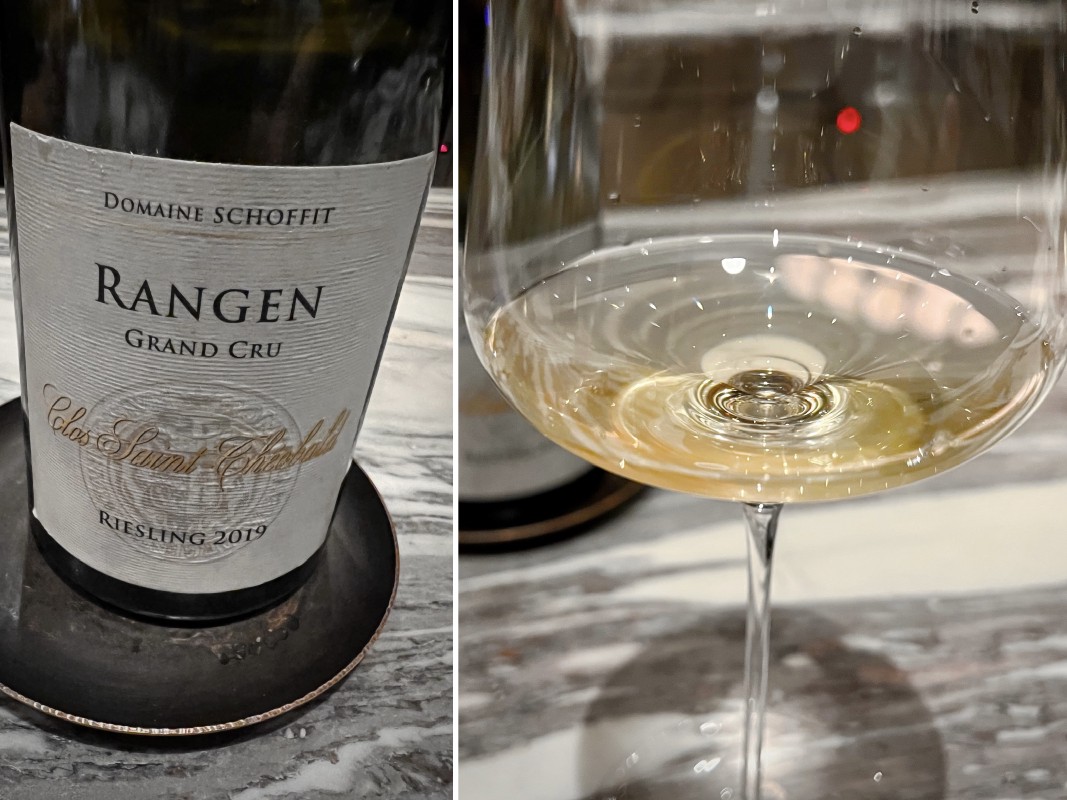
The third pairing is Domaine Schoffit, which was a riesling and came from Clos Saint-Theobald, Rangen, Grand Cru, Alsace 2019. This riesling was probably more similar to other rieslings I’ve had. Even then, it tasted very crisp with many mineral notes, and it’s very full body.

The Norwegian king crab came with gyeran jjim and anchovy. “Gyeran Jjim” was gently steamed eggs with poached king crab, poached in an anchovy broth, and finished with some small mushrooms. This is similar to the steamed egg dish that Korean BBQs serve, but much more refine on the palette. The king crab meat was fairly generous, and the broth was very flavorful.
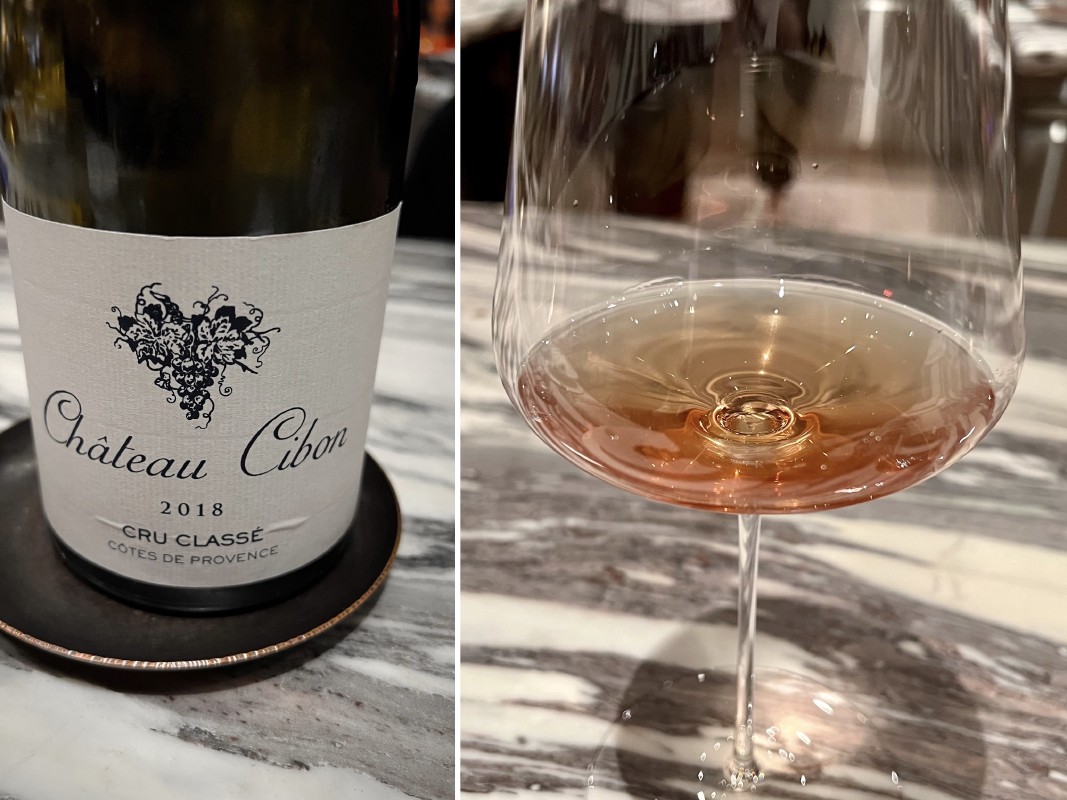
The fourth pairing was the Chateau Cibon, which came from Cuvee Manus, Cru Classe, Cote De Provence, France 2018. This was a type of rose that was simply incredible. The appearance of this was slightly orange with some pink notes in it. It definitely had some red fruit and oaky flavors. It felt very elegant, balanced, and made me question for a second that I was actually enjoying a rose.
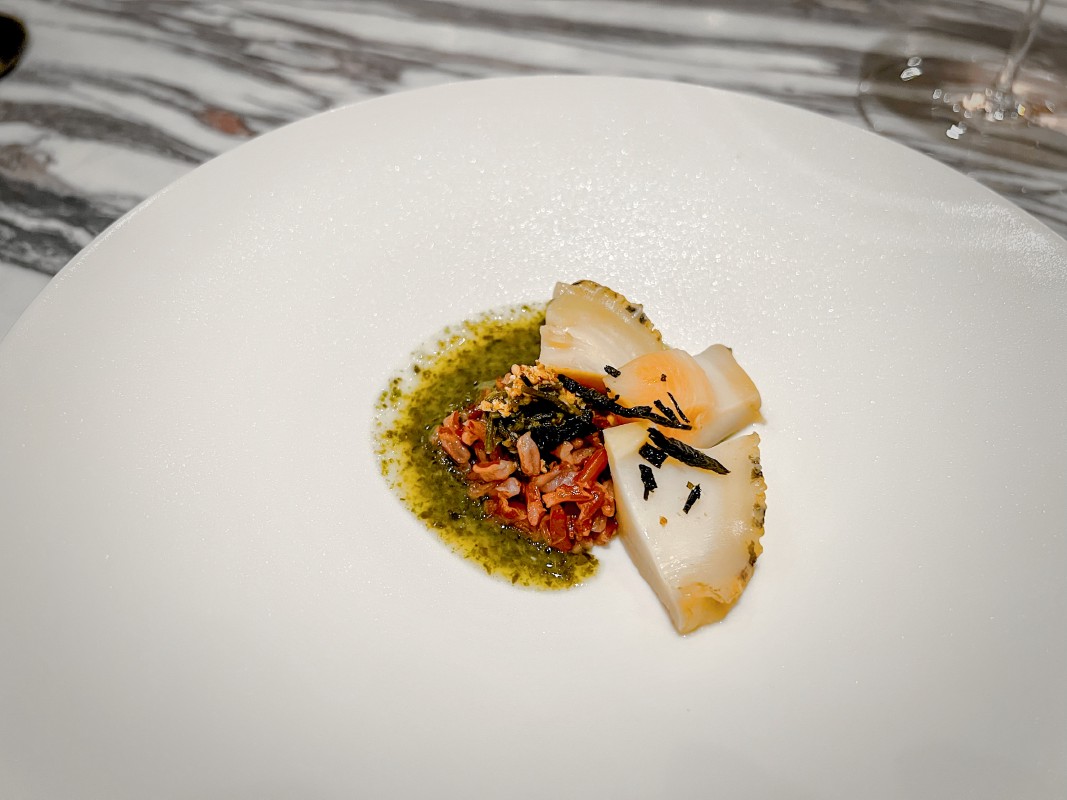
The abalone sourced from Korea and came with bhutanese red rice, tot, and miyeok. The miyeok sauce is a very rich seaweed sauce that is very umami and full of flavors. This sauce was inspired by Korean seaweed soup that is traditionally served for birthdays. If you’re a fan of nori like I am, you will really enjoy this dish. The abalone was crispy and tender, and when paired with the seaweed concentrate, it’s sublime.
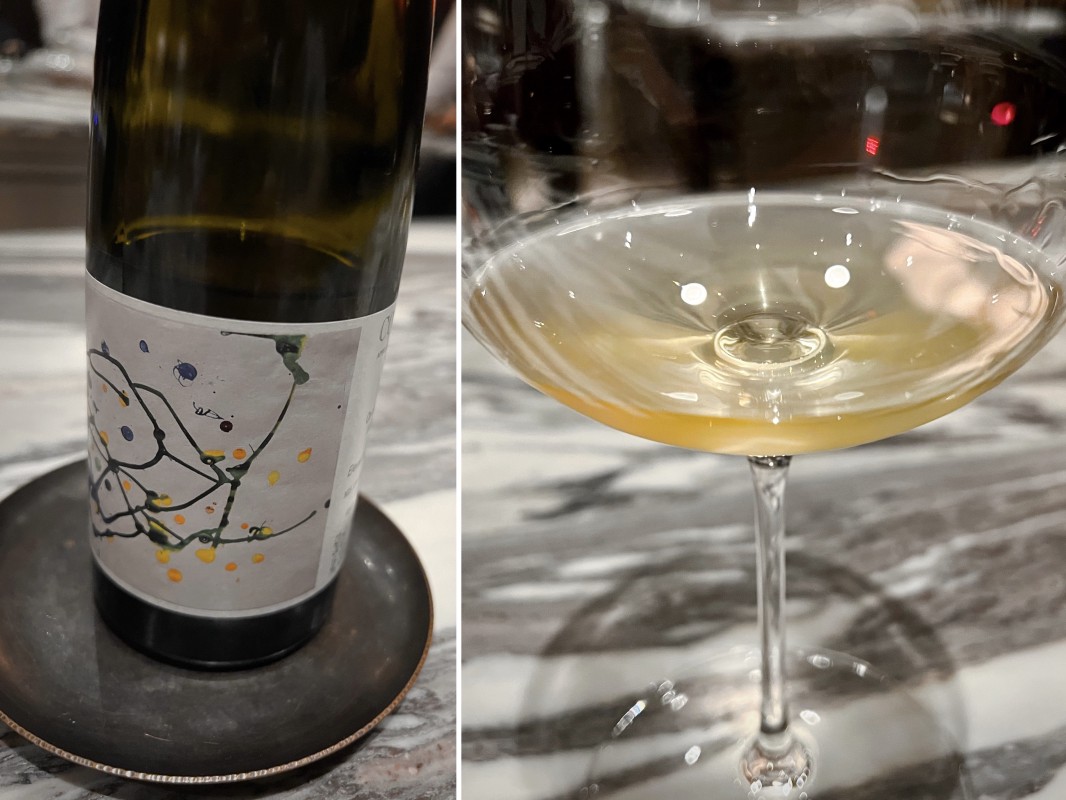
The fifth pairing was the Jean-Michel Stephan which came from Le Tinal, Condrieu, France 2021. This was very balanced between fruit, savory spice, earthy notes, and herbal sensations. The wine was very aromatic and had a lot of vibrant energy.
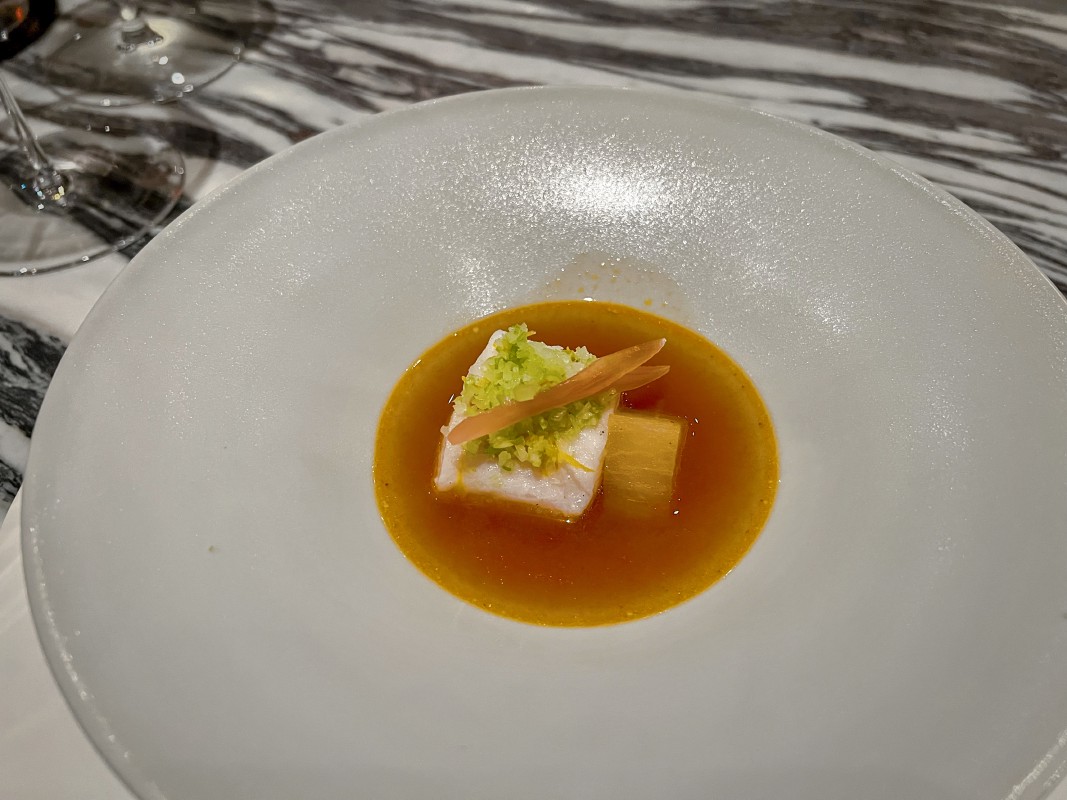
The sablefish, commonly known as black cod, came with moo jorim and meyer lemon. Moo jorim is an anchovy braised Korean broth. The fish was quite tender and cooked perfectly. At the first sip of the broth itself, the anchovy notes were very bold at first, but subsided as you eat the different ingredients. The flavors of the dish became well balanced and very enjoyable.
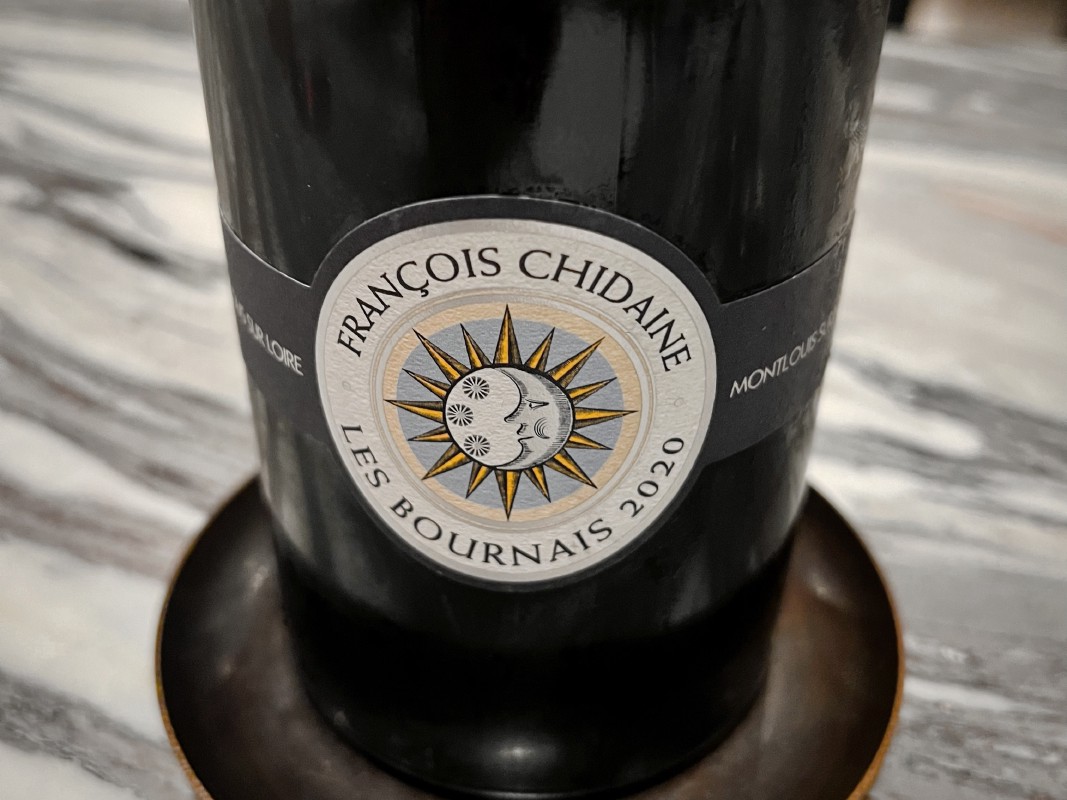
The sixth pairing was the Francois Chidaine which came from Le Bournais, Montlouis Sur Loire, France 2020. This was a full bodied white wine that was very aromatic and had a noticeable funk to it. It has some chamomile notes to it with some minerality around it. It was quite interesting!
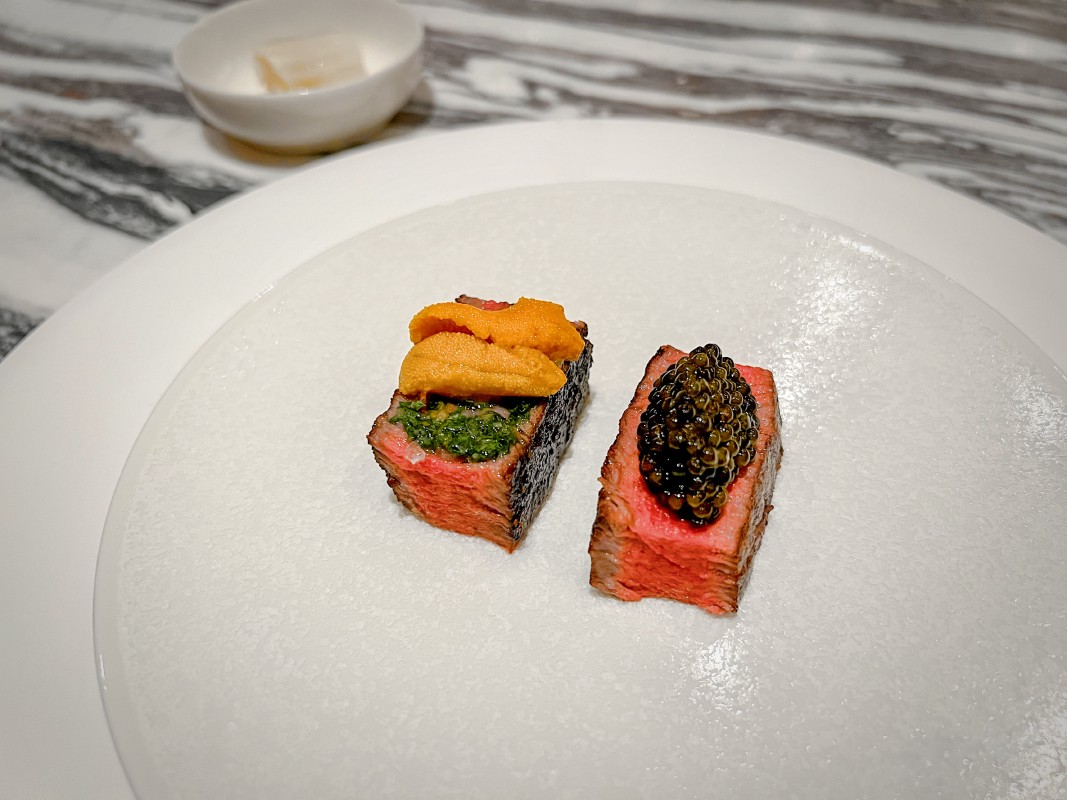
The tenderloin came from Australia with ossetra caviar, hokkaido sea urchin, and perilla. The left tenderloin was wet aged for 20 days and topped with perilla chimichurri and sea urchin. The right piece was also wet aged with the same process, except there is an additional 7-10 days where it’s aged in koji. Koji is the type of mold that is used in producing Japanese rice wine and soju. The result of this will give off some funky nutty characteristics, so they place a generous dop of caviar to balance it out. I don’t know how much I really believe in what they say, but both were very delicious. When you go back and forth between the two meats, you can tell there are very distinct flavors. The left tenderloin was delicious, but the right one definitely had something that told me the differences between short aged and longer aged meats.
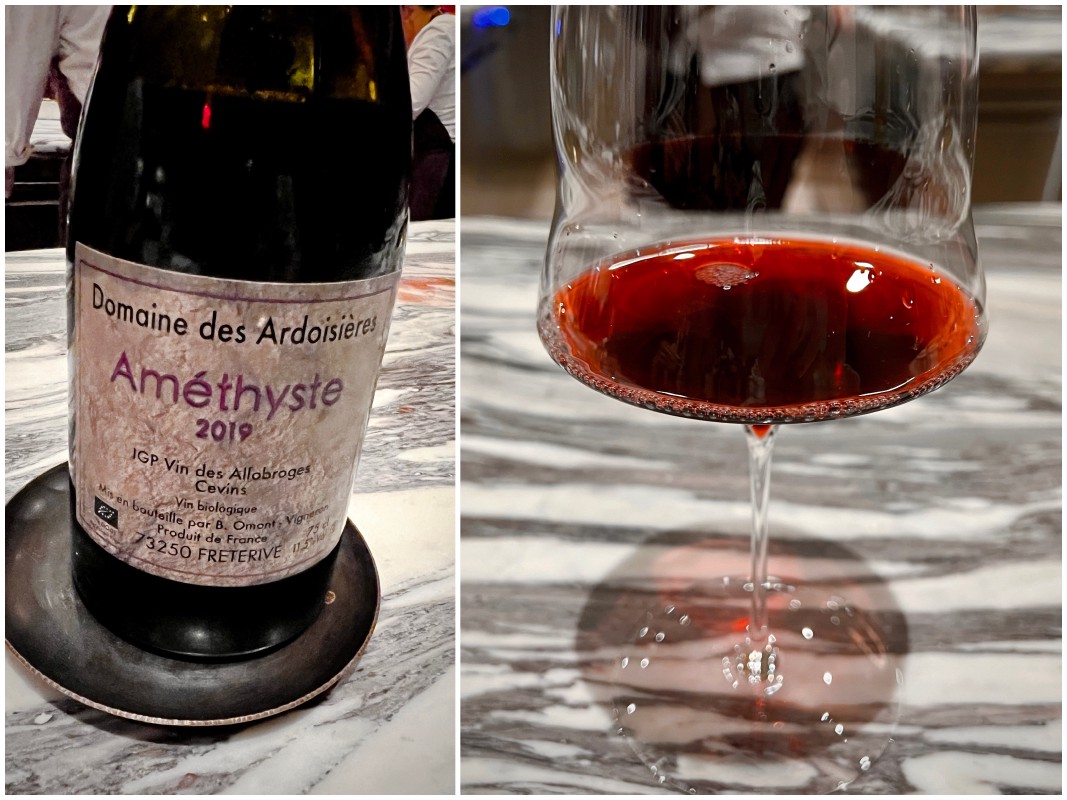
The seventh pairing was the Domaine Des Ardoisieres which came from Amethyste, Savoie, France 2019. This had a lot of minerality and darker fruit notes. It was quite complex, but also very delicious with the next course.
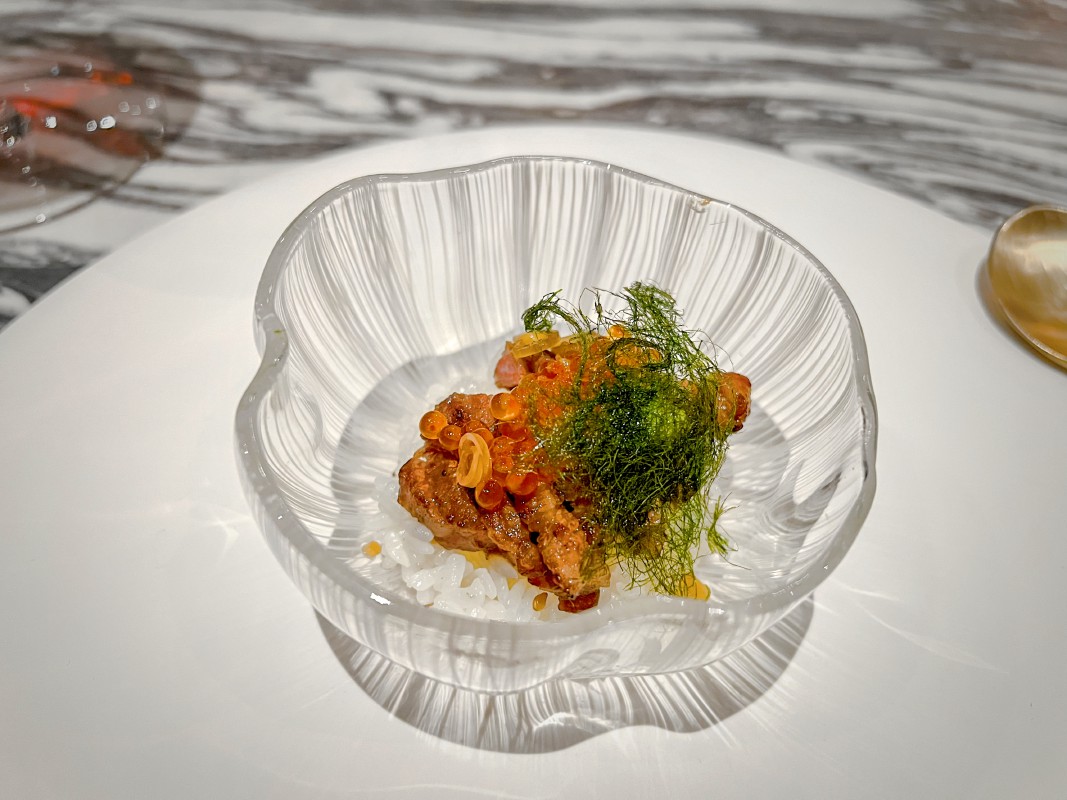
The wagyu galbi from Snake River Farms in Idaho and was topped with smoked golden trout roe, and mukeunji (fermented kimchi). The short rib was marinated in-house for 2 hours and served on top of seasoned white rice and aged kimchi. It was garnished with grated wasabi and a seaweed salad. This was so good. Imagine galbi (short rib) being super tender with a lot of flavors, and it just really knocks it out of the park. The golden trout roe was gave it a smokey and delicious salt flavors when you pop it and eat it with everything else.
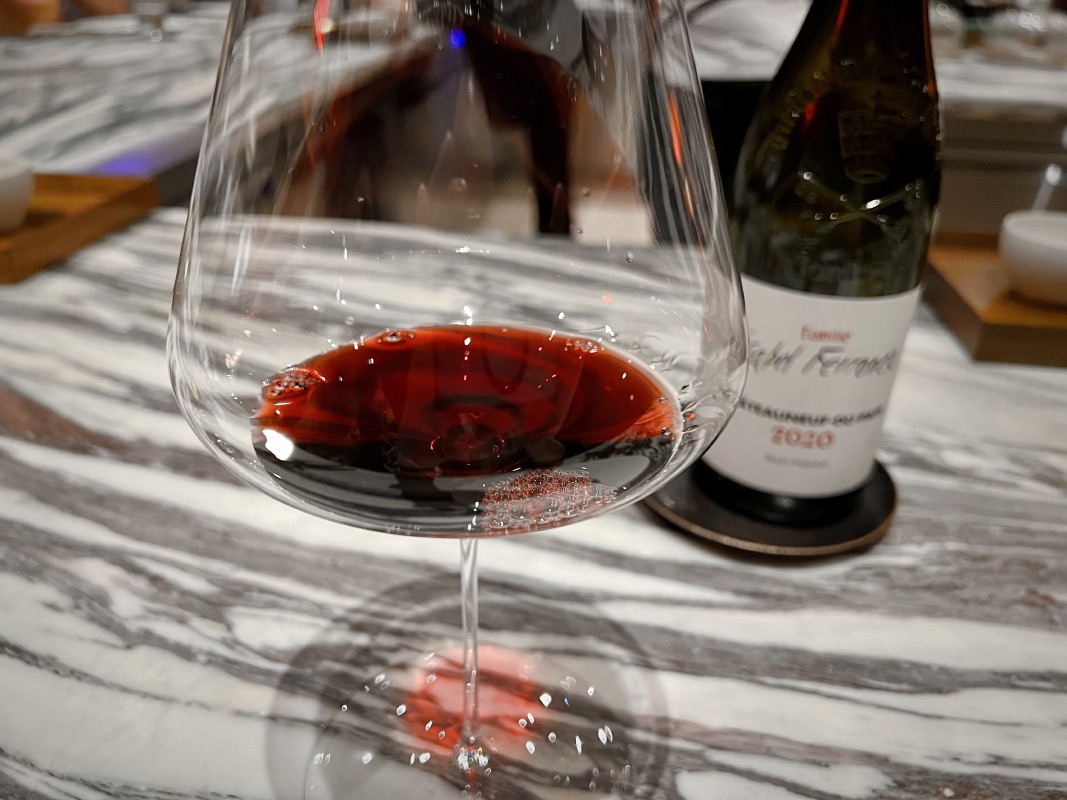
The eighth pairing was the Famille Isabel Ferrando, which came from Chateauneuf-du-Pape, France 2020. This is a red blend that has beautiful dark notes with full body flavors. It’s very multi-dimensional, and complicated to describe, let alone remember all the details. It definitely had notes of raspberry and cherry fruits, and it had excellent minerality.
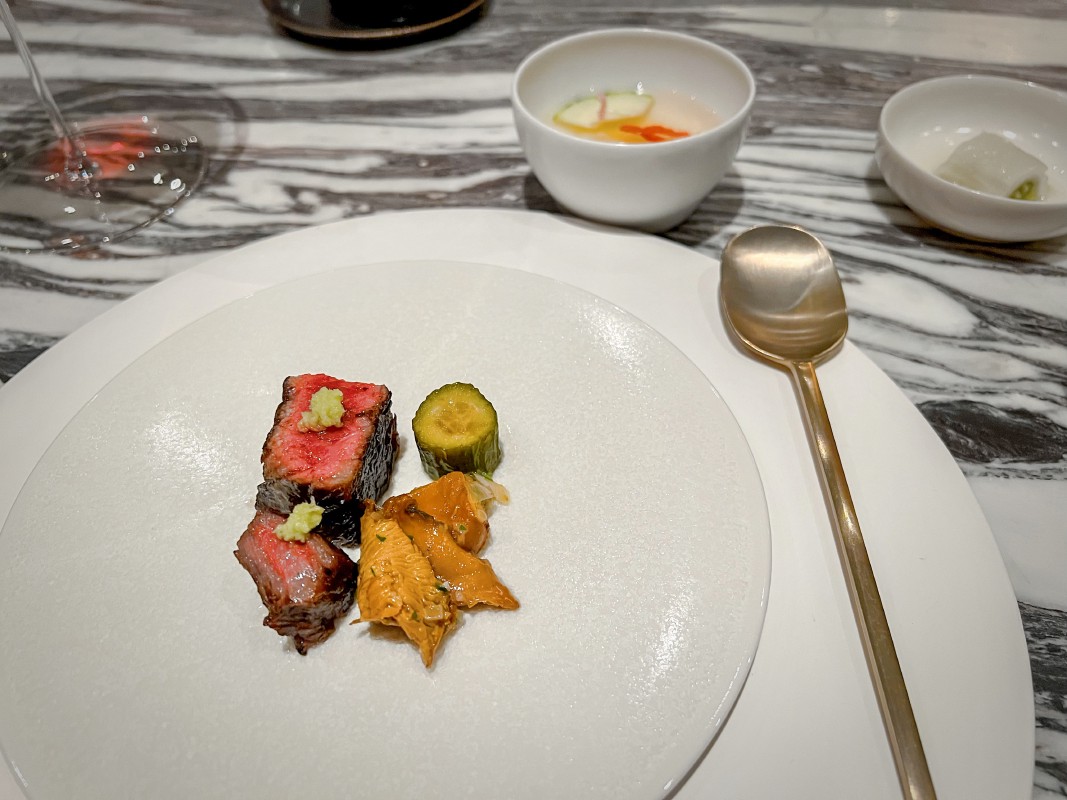
The A4 kagoshima came with oiji (Korean cucumber pickles) and nabak (water fermented) kimchi. The wagyu had some freshly grated wasabi on top of it. For those that don’t know, freshly grated wasabi is very different than the sushi wasabi paste that restaurants give you. This type of wasabi gives an interesting peppery and zesty character to the dish. The A4 was very delectable and was incredibly rich. They ask that you go back and forth between the oiji broth and the wagyu to balance your palette.
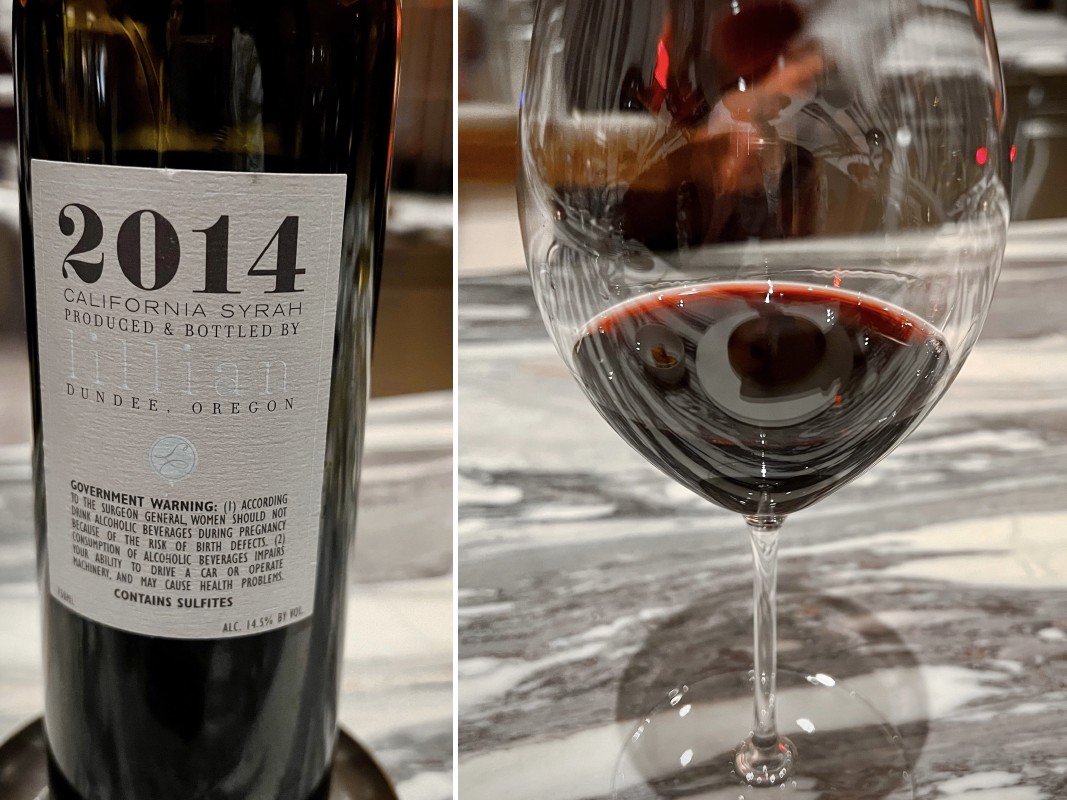
The ninth pairing was the Lillian which was a syrah from Santa Barbara, California 2014. This would be for our final 2 meat courses. This was a new world red wine that was bold, slightly more tannic, dry, and very well balanced. I’m generally not a fan of syrahs, but this one was very structured and approachable.

The dry-aged ribeye came with celeriac, truffle puree, and tomato geotjeori (fresh kimchi). The rib eye was aged in the same koji as the tenderloin above. At the north end of the picture is a cup of small cherry-like tomato slices, soaking in a cold broth. The tomatoes were very flavorful and vibrant.
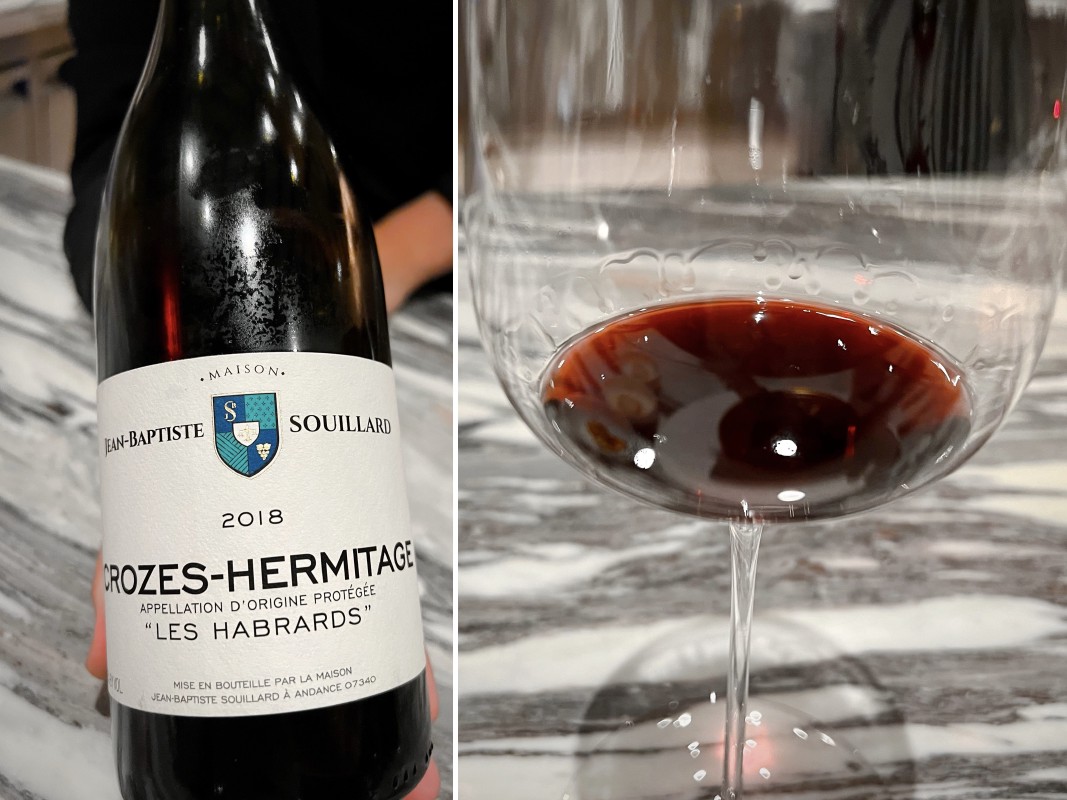
I had asked the sommelier a question about how do you tell between new and old age wines, and they gave us a complimentary pour of the Jean-Baptiste Souillard Crozes-Hermitage, which came from Appellation D’Origine Protegee “Les Habrads”, France 2018. Compared to the new world Lillian from Santa Barbara, this had more earthy tones, but it wasn’t as complex. It was still good though with its bright fruit aromas.

The final savory course of the evening was the hansang charim, which came with gondrea namul rice, moo guk, and banchan.
At the bottom of the plate setting (left to right):
- gondrea namul rice - this was the same rice that was served with the wagyu galbi
- moo guk - this was a simmered radish soup with some Snake River Farm wagyu short rib
In the center (left to right):
- green mustard kimchi
- seaweed stems with cucumbers
- assorted pickled daikon radish
In the top (left to right):
- seaweed sheets - these can be used to make hand wraps with the rice and the sauce
- “Nam nam?” sauce - this reminded me of a vinegar and chili pepper medley and was really good.
This whole final course was a great savory cap for the night before heading towards dessert.
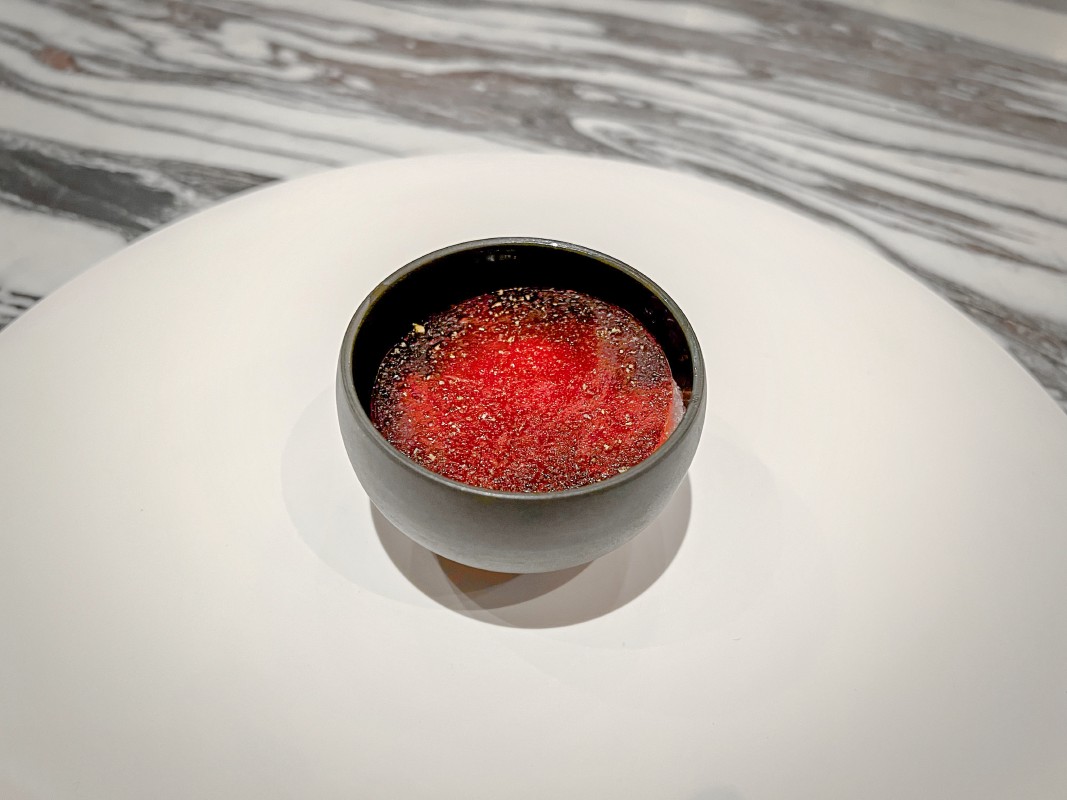
The lemon and blueberry posset came with gukhwa (chrysanthemum granita) and makgeolli (milky alcoholic rice wine). This came with pickled blueberry and blueberry tuile on top. The tuile had a similar texture to a creme brulee where the sugar is crystallized. The custard was very good.
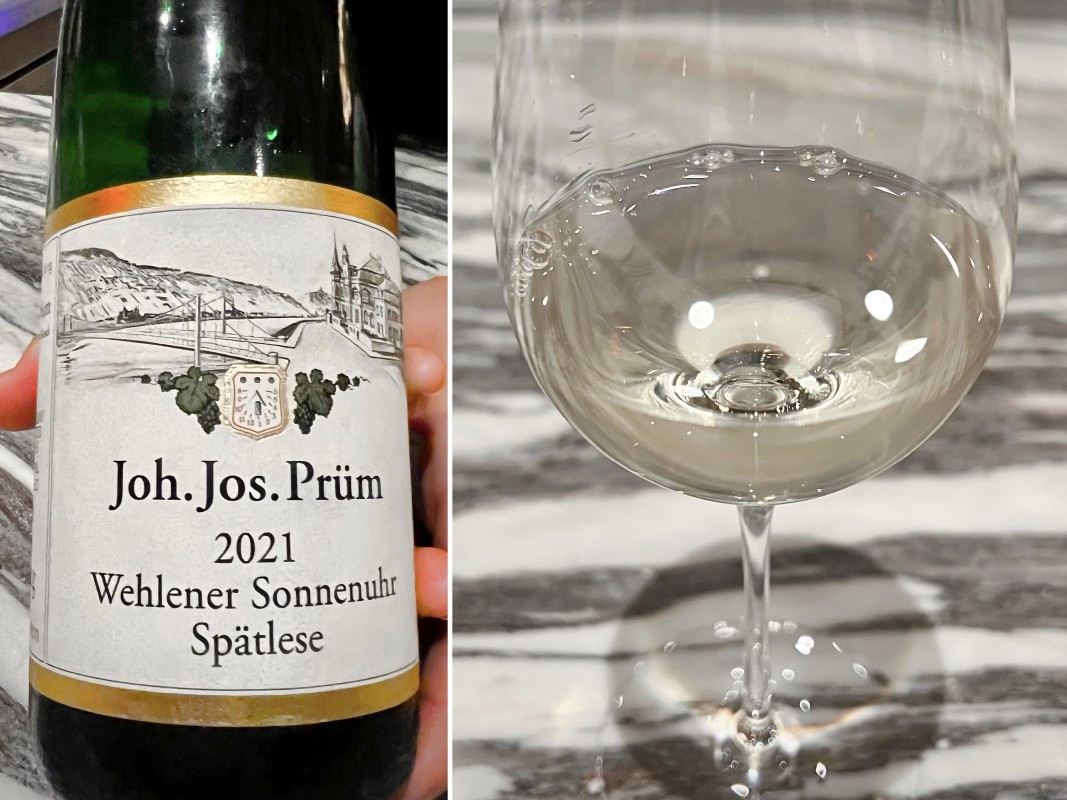
The tenth and final pairing was the Joh. Jos. Prum, which came from Wehlener Sonnenuhr, Spatlese, Mosel, Germany 2021. This was actually really good despite it being a riesling and served with dessert. There was actually some sweetness to it, but it was mellow and worked well with all the desserts tonight.
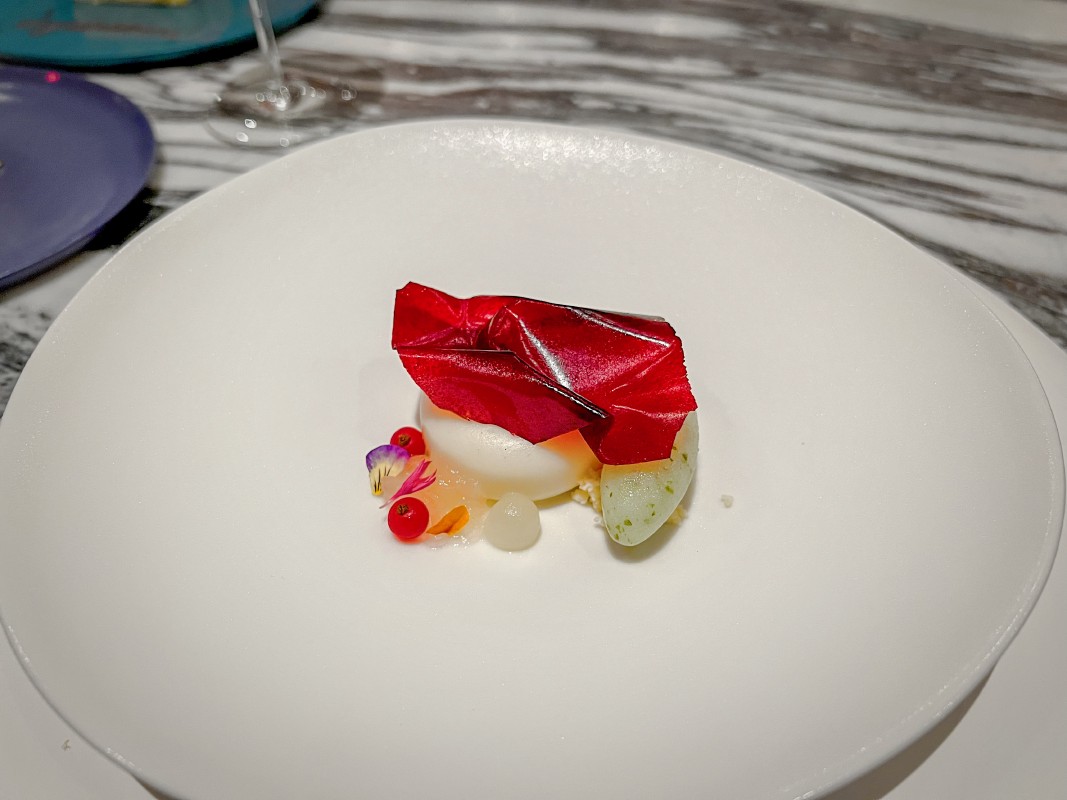
The chamoe (Korean melon) came with lemon verbena sorbet and cassis. In the middle was a panna cotta flavored with Korean melon. The fancy, decadent “fruit rollup” looking thing was a black currant tuile. There were little balls of Korean melon. The lemon sorbet added some nice tart to all of this. It was a very refreshing and delicious dessert.
The next two desserts were to celebrate not once, but twice over some milestones for us.
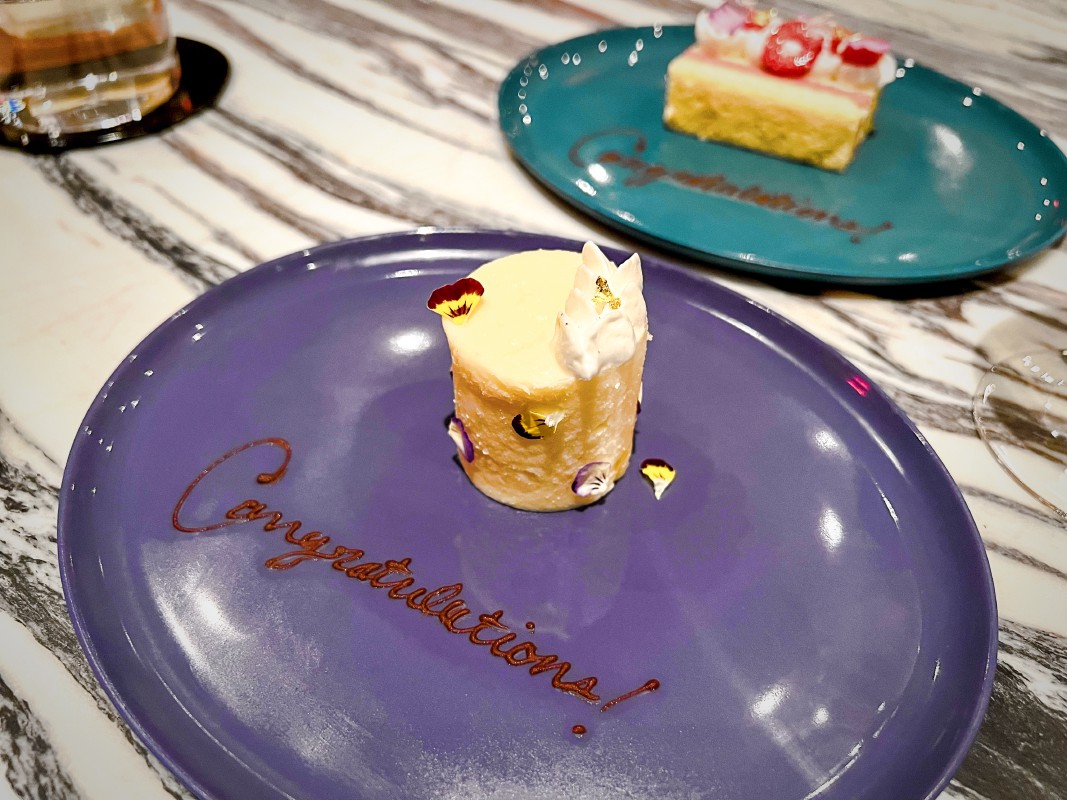
The toasted buckwheat mousse came with a burdock root sponge. Despite them saying it’s a sponge, the texture was more similar to a white chocolate chunk. It wasn’t as soft as you would think, but had a hard chocolate like texture where you can kind of “dig” through it. It was not too sweet, and it tasted very good.
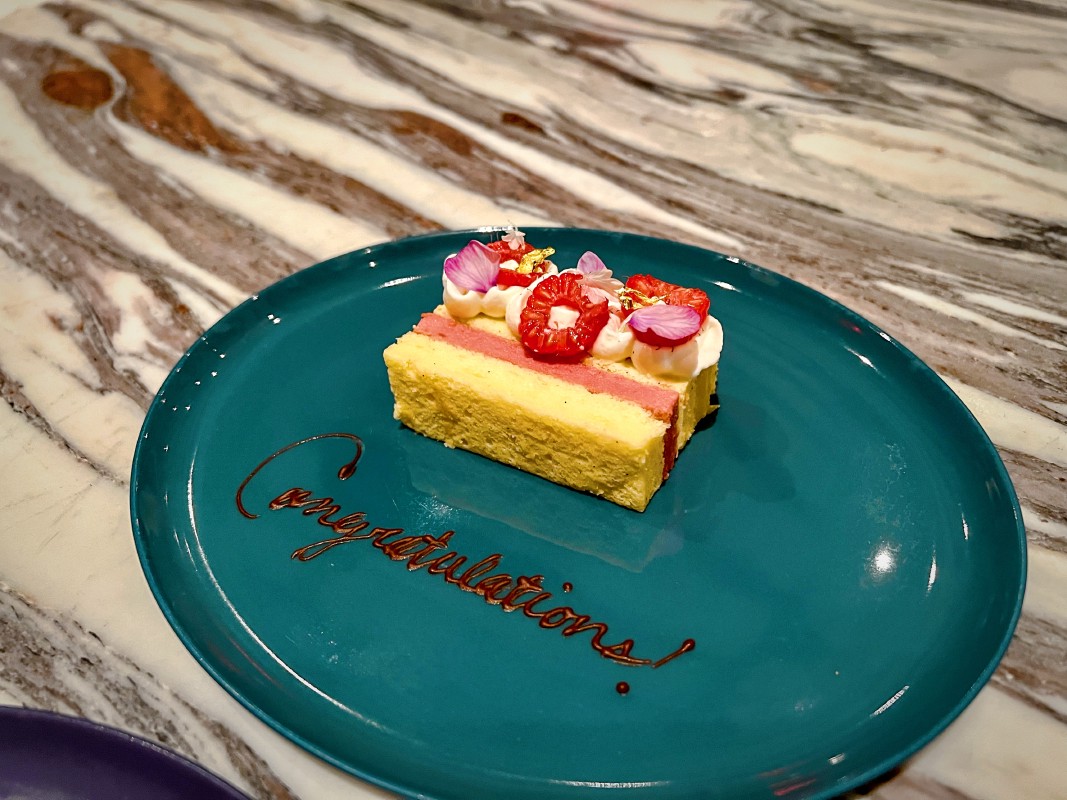
The raspberry and passion fruit castella cake was similar to those Asian style pound cakes. The difference though is that the passion fruit and raspberry flavors were very bold and perfectly sweet. I loved this. The cake itself was not too airy, and it was dense such that you can pick it up easy and not crumble.
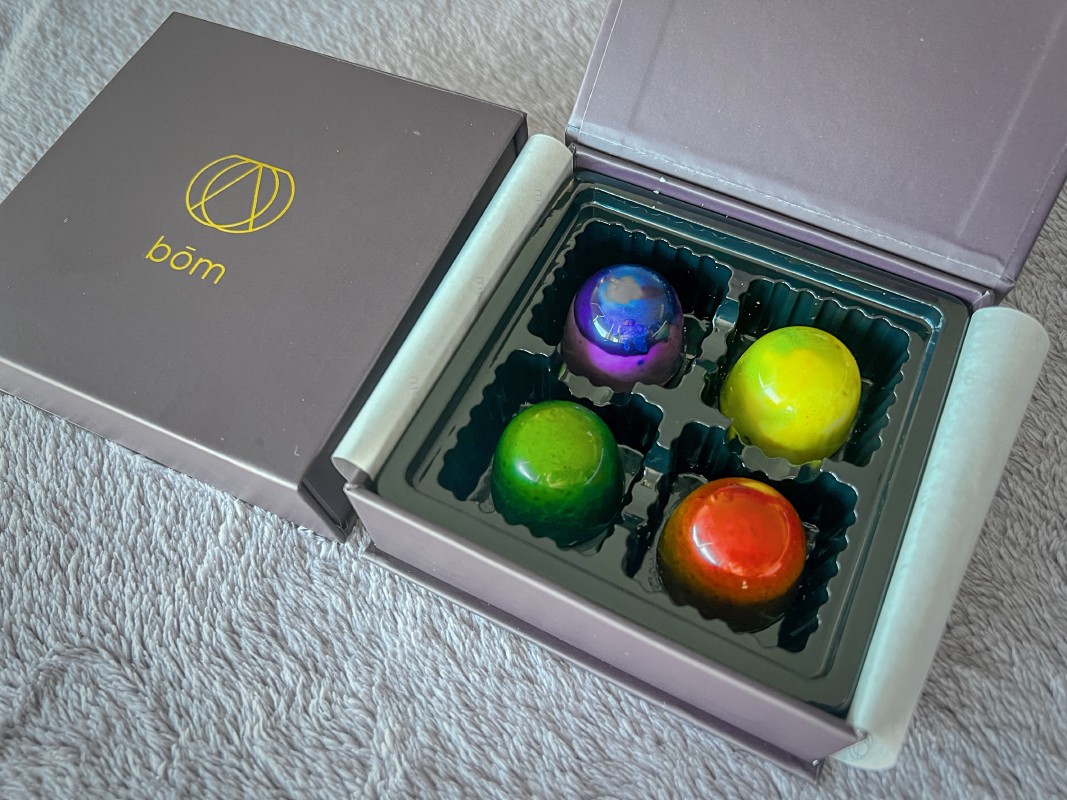
To carry out, they gave us a box of 4 chocolates and the menu. What was very impressive to me was that these boxes had a magnet latch. I can’t imagine this being super cheap or anything, but it was very nice that they put some thought into the presentation. It’s been a while since I’ve seen high end restaurants do this.
The flavors from top right clockwise:
- passion fruit - chocolate and passion fruit, what more can you ask?
- pistachio and beef galbi(?) - this was interesting. There was a red color jam in it that reminded me of the galbi dressing. So it was a nutty and sweet flavor that also struck me as savory.
- mint(?) and caramel - the caramel was very wet but delicious, and the mint was not peppery, but flavored.
- some type of sweet bean with açai coloring - this reminded me a little of red bean, but it was very nutty. I can’t quite figure out the taste, but it was delicious.
Final Verdict
Bōm was outstanding. All of the courses we had today were delicious, especially the steak courses, and it would be hard for us to really pinpoint anything that was bad.
Compared to some other Korean Michelin restaurants, it’s definitely up there. It would easily give Cote a run for high end Korean steak. I told my partner that I thought this restaurant’s flavors were slightly better than Atomix restaurant, but I think Atomix Bar still holds a place in my heart. And Jungsik is starting to fade a bit considering these new Korean restaurants being much more modern and experimental.
If you do end up checking this restaurant, definitely try to splurge for the wine pairing. It has some very unique wines that are of the new world and offer distinct but playful touches on how it pairs with the food. Big props to the sommelier and the restaurant for offering a fantastic experience. I would not be surprised if this ends up getting at least 1 Michelin Star.
Yelp Jabs
Exciting wine pairing by their reputed sommeliers with their extensive wile selection is a must! Thanks for fantastic dinner!
Their wine pairing is something that is different than most restaurants. It’s very fun and somewhat experimental. I have not had so many exquisite wines before, so it was great to sample a bunch.
Revisions
- Aug 26, 2023 - Initial revision.